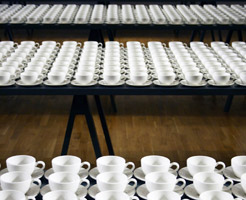The Independant - June 2013
Saucersful of secret good deeds inspire art-lovers at London's Foundling Museum - Alice Jones
Will you get a lucky ticket? From next Friday, 10 visitors a day to London’s Foundling Museum will be randomly selected to take home an artwork. The catch? They have to promise to do a good deed in return.
Ceramic artist Clare Twomey has filled a room with 1550 customised cups and saucers, each one of which is printed on the base with an instruction. If the selected ticket-holders agree to it, they keep the cup, leaving behind a saucer printed with a reminder of their good deed. Gillian Anderson and Penelope Curtis, director of Tate Britain are among the hundreds who have suggested favours, ranging from the simple, “Buy a Big Issue”, “Send flowers to your Mum” to the life-changing “Adopt a child.”
“That could be the one cup left at the end of the exhibition, or it could be the inspiration for someone to do that”, says Stephanie Chapman, Curator at the museum. “Others are really interesting, like ‘Offer to cut the toenails of an old person’ – a good deed that is genuinely useful.”
The Foundling was established in 1739 as a hospital for “exposed and deserted” children. Hogarth and Handel were among the early supporters of the charity, helping to create the UK’s first public gallery with their contributions. Twomey’s work, titled Exchange, continues this tradition of artistic philanthropy. The room full of rows of cups laid out on five long trestle tables is designed to evoke the refectory of the old Hospital. The act of swapping cup for deed, meanwhile, is meant to mirror the heartbreaking exchange of the mothers who left a child with the charity in the hope of a better life.
“Some of the good deeds are quite simple, some are quite challenging so people will really have to think before they take the cup”, says Chapman. “They will all sign a log book and we’ll encourage them to feedback via social media when they have done their deed.”
Time Out - April 23rd 2013
Exchange: 1,000 Good Deeds
Would you agree to perform a mystery good deed in exchange for a work of art? This unusual exhibition at the Foundling Museum is banking on your co-operation. Based on the work of British ceramic artist Clare Twomey, the show centres on 1,000 identical cups and saucers, each with an inscription describing a good deed concealed between the base of the cup and the plate. Lift the cup and accept the good deed challenge, and you get to take home the tea-drinking paraphernalia.
When it come to creating site-specific installations, Twomey has plenty of previous experience. Two years ago, in a work called ‘A Dark Day in Paradise’, she colonised the flamboyant Regency rooms of Brighton’s Royal Pavilion with a menacing cloud of 3,000 black ceramic butterflies. In that instance, Twomey was responding to the building’s history of hedonism and excess. In ‘Exchange’, she has been inspired by the philanthropy reflected in the Foundling’s touching social history collection. The museum tells the story of England’s first hospital for abandoned children, founded by Thomas Coram in 1739. Along with artworks by William Hogarth and other founding benefactors, its collection includes a poignant display of small tokens left by mothers forced by destitution to leave their children in the institution’s care.
Back to those tea cups, though. Don’t expect simply to turn up and snaffle one. Only a certain number of visitors will get the chance to pledge their help: ten cup-for-deed exchanges will be made each day (check the website or ring the museum for timings). And the kind actions required vary in nature. Twomey worked with former pupils of the Foundling Hospital School, museum supporters, local residents and children in care to come up with suggestions that range from ‘smile more’ and ‘buy a Big Issue’ to ‘don’t use any new plastic bags this year’ and ‘put flowers on a stranger’s grave’.
Those who choose to accept their challenge will take the cup away as a permanent reminder of a shared experience and a commitment to reach out to others. The museum, meanwhile, would like the growing band of participants to report back. Messages, which might take the form of a photograph, a video or a simple written account, will form part of the ongoing display and appear on the website, creating a unique record of doing good in the capital.









